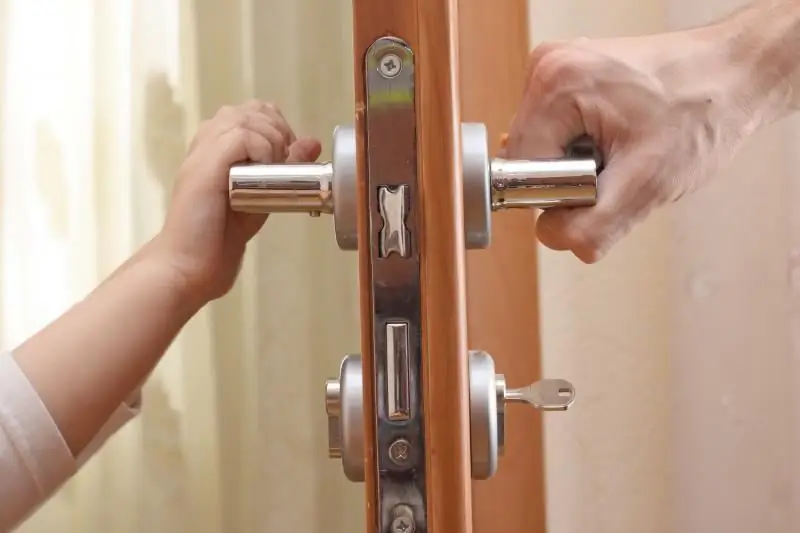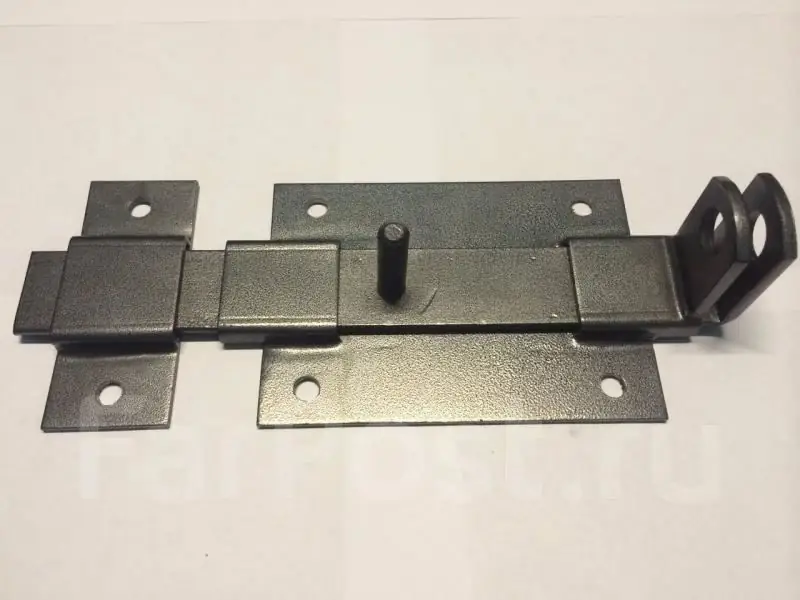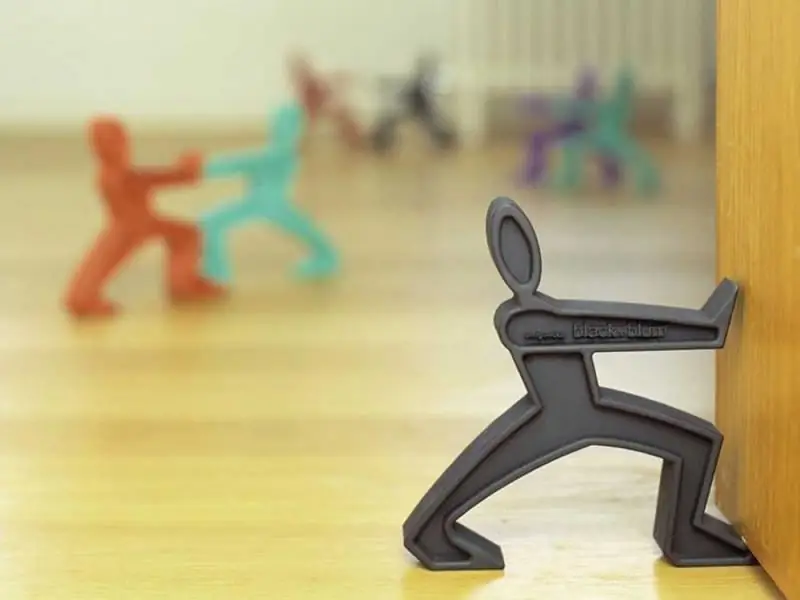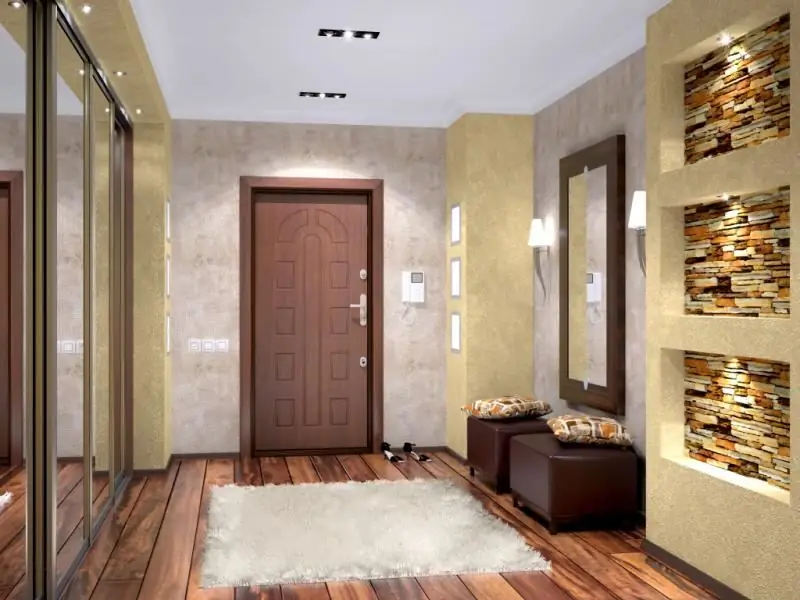
Table of contents:
- Author Bailey Albertson [email protected].
- Public 2023-12-17 12:53.
- Last modified 2025-06-01 07:32.
Types of door handles and their features

One of the main elements of the door hardware, which is constantly in sight, is the handle. Modern industry offers a large selection of various models, so buying a door handle requires some knowledge. It should not only fulfill its intended purpose with high quality, but also be a decoration for the door, and also organically fit into the interior of the room.
Content
-
1 Purpose and design of door handles
1.1 Features of the device and operation of door handles
-
2 Types of door handles
- 2.1 Bail handle
- 2.2 Snap handle
- 2.3 Round handle
- 2.4 Knob-button
- 2.5 Locking handle
- 2.6 Handle bar
- 2.7 Handles for sliding doors
- 2.8 Video: types of door handles
-
3 Features of mounting door handles
-
3.1 Fitting the snap handle
3.1.1 Video: Installing the snap handle
-
3.2 Mounting stationary handles
3.2.1 Video: marking the place for mounting the handle-bracket
-
3.3 Installing handles for sliding doors
3.3.1 Video: installation of handles for sliding doors
-
-
4 Repair of door handles
4.1 Video: door handle repair
- 5 Reviews
Purpose and design of door handles
The handle is one of the essential elements of the fittings with which you can open or close the door. In addition to its functional purpose, it is a door decoration and must correspond to the design of the room. Modern handles come in a wide variety of shapes and are often a highlight of the interior. They differ not only in their appearance and structure, but also in material, shape and size.
By location, there are two types of pens:
-
for entrance doors. Here, not aesthetic appearance is more important, but reliability and strength, since the weight of the canvas is large and the handle must withstand serious loads. Often, the front door handle is equipped with armored strips that protect the lock core from being opened by burglary or drilling;

Front door handles The handle for the front door must be designed for heavy loads
-
for interior doors. They are more graceful in appearance and not as massive. Despite this, their reliability must also be high in order to ensure the opening / closing of the door over a long period of service.

Interior door handles Handles for interior doors are distinguished by more graceful shapes, since they should organically fit into the interior of the room
Features of the device and operation of door handles
Depending on the selected type of door handle, its structure and operating principle will differ:
-
Push or lever. They open the door by pressing the L-shaped handle. The latch, built into the structure, allows the door leaf to be fixed in the closed position. Lever handles can have plate or rosette overlays. The first option is usually used with a lock, in which the latch and bolt are activated by a key. When choosing such a handle, one must take into account the distance between the centers of the keyhole and the handle, the width of the decorative strip, the size of the square pin and the shape of the keyhole. Otherwise, only the size of the overlay matters. If a latch lock without a bolt is used, a handle with a rosette is usually installed. It consists of the following elements:
- two push handles;
- internal mechanism;
- tongue lock;
-
decorative overlays.

Lever handle device with socket Lever handle with rosette used in conjunction with a conventional latch
-
Push-button. This is a type of push-down design in which the handle is in the shape of a ball. Such models are also called knobs. To activate the latch, here it is not necessary, as in the previous version, to press the lever, but it is enough to turn the ball. The keyhole is in the center of the handle. Most often, push-button handles are installed in a toilet or bathroom. The door can be closed from the outside with a key, and from the inside using a button or latch located directly on the handle.

Push button handle To activate the latch, just turn the handle
-
Stationary. They are intended only for opening the door leaf and differ in that they are not connected to a lock or latch. The stationary handles do not move, so you cannot push or turn them. Such models are fixed by means of tightening screws or using self-tapping screws. Due to the design of the stationary handle, only the roller catch can be used with it.

Stationary door handles Stationary handles serve only for opening / closing doors
Different materials can be used to make door handles:
- wood. These handles are ideal for solid or veneered canvases, but should not be installed in rooms with high humidity. To ensure maximum strength, abrasion resistance and durability, the wooden handles are made from hardwood;
- steel. The door handles are made of steel and stainless steel. To protect them from corrosion, a special coating is applied, usually chrome or nickel plating;
- brass. Such structures are highly durable and reliable, tolerate temperature drops and high humidity well. In addition, they are lightweight and warm to the touch;
- aluminum. These models are not as durable as the previous ones, but they are cheaper;
-
glass;

Glass door handles Glass door handles add flavor to the interior
- porcelain;
- a rock.
Types of door handles
To choose the right doorknob, you need to understand the features of different options for their execution and consider the advantages and disadvantages of each of them.
Staple handle
The main difference between such models is reliability and simplicity. Staple handles can have a variety of shapes; different materials are used for their manufacture. They are used in cases where a locking device is not provided on the door.
The main advantages of the staple handle:
- simple and reliable design. There are no mechanisms here, so there is nothing to break;
- long service life. If the surface has worn out during operation, it can be renewed, after which the handle will look beautiful again and fulfill its purpose for many years;
- big choice. Such models are presented in a wide range, there are both modern solutions and semi-antique options, so you can always choose the one that meets your requirements;
- simple installation. To fix the handle, just screw it to the door leaf with self-tapping screws.
The handle-bracket can be made:
-
made of PVC, such products are intended for installation on metal-plastic doors. Most often they are painted white and have a length of 250 mm;

PVC handle PVC handle-brace is usually installed on metal-plastic doors
-
made of metal. They are mounted on the entrance aluminum or metal canvases both inside and outside the room;

Metal handle-bracket The metal handle-bracket is installed on aluminum or metal canvases both inside and outside the room
-
semi-antique. These are modern models that are stylized in the old days. Often such pens are made by hand, so their cost is usually high;

Antique handles Antique handles are often made by hand
-
for a bath. The handle is usually made of wood and the mount is made of metal. You should not install such a handle on the door from the side of the steam room, but for other rooms of the bath it will be ideal;

Bath handle The bath handle has a wooden handle and a metal base
-
for interior paintings. These models can be of different shapes, colors and sizes;

Interior door handle If there is no need to fix the interior door, you can install a bracket handle on it
-
for utility rooms. The difference between such models is in their low cost, and their reliability and durability are at a sufficient level.

Handle-staple for outbuildings For doors in household buildings, simple and reliable handles are usually used.
Polymer paint, electroplating or oxidation can be used to protect the handle surface from damage and corrosion.
Snap handle
The door handle with a latch allows you to securely fix the curtain in the closed state. The following latches can be used:
-
fale. Here, the locking element is made in the form of a tongue, on which there is an oblique cut on one side. The tongue is pressed by a spring, so that it snaps into place, just close the door. To open the door, press the handle;

Latch handle The door is fixed with a latch-tongue
-
with magnets. Such a latch consists of one or more permanent magnets and a metal bar. Simple models work on the same principle as furniture magnetic latches;

Magnetic handle The door is fixed in a closed state due to the installed magnet and a metal plate
-
roller. Stationary handles are often fitted with this mechanism. The roller is spring-loaded and fixes the door when closing, and if you apply a certain force to the canvas, the door will open.

Roller latch Roller latch installed with stationary door handles
When choosing a handle with a latch, one must take into account where the door opens so that it is convenient to turn it
Round handle
Round handles are great for interior doors. Such designs have replaced the traditional handles-staples. Their advantage is that they fit more comfortably in the hand and have a more attractive appearance.

Round models look more attractive compared to the staple handle
Knob-button
The difference between this design is its appearance. It got its name from its external resemblance to a button. Different materials are used to create knobs, so you can choose a model for any interior.
Button handles are usually made of wood, metal, or plastic. They can be installed on any door. The disadvantage of wood fittings is that over time, its surface wears out, so it is necessary to periodically cover the handles with varnish or paint.
Depending on the type of construction, the handle-button can be:
-
paired. They are mounted on the same axis; for installation, a through hole must be made in the door for a tightening screw. It is imperative to install two handles;

Twin handle-button Paired handles are connected with a lag screw
-
single. They are fixed to the door leaf with self-tapping screws, so they can only be mounted on one side of the door. If you need to install such handles on both sides of the door, then they do not have to be located one opposite the other.

Single handle-button The single handle can only be installed on one side of the door
Locking handle
If it is necessary to lock the doors so that a stranger cannot enter the room, handles with latches are used. They are usually installed in a bathroom, toilet or bedroom.
Rotary knobs are often provided with locks. Their structure is almost the same as that of lever models. To operate the latch, simply turn it. If you need to lock the door, then you can do this with a button, a rotary latch or a key, it all depends on which model you buy.

To lock the doors, just turn the lock on the handle
You should not buy cheap silumin products, since their strength is low, so they fail very quickly
If there are elderly people or small children in the house, then sometimes it becomes necessary to open the locked handle with a latch from the outside. To do this, you need to find a hole at the bottom of the handle through which you can get to the blocker. It is enough to insert a knitting needle, nail or other sharp object into it and slightly press on it. After such actions, the blocker key is pushed out and the door can be opened.
Handle bar
For maximum safety on public doors, it is recommended to use bar handles. Popularly, such devices are called "anti-panic pen", because in the event of a critical situation, you can open it with a light touch of your hand and quickly leave the room, while outside they will be inaccessible for unauthorized entry.
Depending on the model, the length of the handle bar can be 80, 90 and 98 cm. To create such products, only high-quality materials are used, it can be steel, aluminum or plastic. The rod handle has an attractive appearance and can be painted in any color.

The handle bar in the event of a critical situation allows you to quickly open doors from the inside
Sliding door handles
The main difference between handles for folding doors is that they must be flush with the door leaf, therefore they are also called mortise. Otherwise, they are not much different from conventional models. Folding door handles can also have a latch, a catch and even a cover with a slot for opening the lock.

The handle of the sliding door should not protrude beyond the curtain
Video: types of door handles
Features of mounting door handles
For self-assembly of the door handle, you need to purchase the following tools:
- electric drill with a set of drills and crowns;
- chisel;
- a hammer;
- screwdriver;
- measuring instruments;
- pencil;
-
conductor.

Hole drilling jig The jig helps to position the drill strictly perpendicular to the surface
Snap handle assembly
When self-mounting a handle with a latch, the sequence of actions will be as follows:
-
Layout of the canvas. Experts recommend installing the door handle at a height of 80-100 cm, but there are no clear standards. The main thing is that it is convenient to use it. At the end of the canvas, a pencil indicates the place where the latch will be installed. On the canvas itself, they mark the place for mounting the push fittings and its center, since a rod will be installed here, transmitting the force from the handle to the latch. This rod has a square section and is commonly called a square.

Handle installation height The height of the handle is 80-100 cm and is chosen so that the handle is convenient for all residents
-
Making holes. According to the markings made, holes are made at the end of the canvas and on both sides. For this, an electric drill, a feather drill or a crown of the required diameter is used. To prevent chips from appearing on the surface of the door, a hole for mounting the square must be made on both sides. First, the canvas is drilled halfway on one side, and then the same is done on the other.

Drilling holes The holes are made with an electric drill using a pen drill or crown
-
Preparing for mounting the latch. The mechanism is inserted into the holes prepared at the end of the door and the place of its attachment is marked. Using a hammer and a chisel, make a small depression for the decorative strip of the latch. If there is a router, then it is better to use it for cutting grooves.

Preparing for mounting the latch The place for installing the latch is deepened with a hammer and chisel
-
Installation of the latch. It is installed in the prepared hole and fixed at the end of the door using self-tapping screws. To prevent the latch from jamming, before installing it, the hole must be blown out with air and the remains of wood dust must be removed.

Latch mounting The latch is fixed with self-tapping screws
-
Setting a square. It is inserted into the latch and the functionality of the mechanism is checked.

Setting a square The square is inserted into the latch and the operation of the mechanism is checked
-
Installation of handles. First, put one handle on the installed square and attach it to the canvas using self-tapping screws. Then put on and fix the second handle.

Installation of handles The handle is put on a square and fixed on the door leaf with self-tapping screws
-
Installation of decorative caps. The attachment points of the handle to the canvas are hidden with decorative caps, then the screw under the handle is tightened with a hex wrench.

Installing decorative caps Decorative caps hide the handle attachment points
-
Mounting the striker. Now it is necessary to mark the place of contact between the tongue and the box. With the help of a hammer and a chisel, a recess is made here, into which the latch tongue will enter, after which the counterpart is installed.

Mounting the mounting plate The strike plate is mounted on the door frame opposite the latch tongue
Video: mounting a handle with a latch
Installation of stationary handles
It is very easy to install a stationary handle with your own hands; even a beginner can cope with such a task. The sequence of work will depend on whether a paired structure is being installed or a single handle is installed:
-
Installation of a single handle. The place of installation should be marked on the door, then fix the handle with self-tapping screws.

Installing a single handle You just need to fix the handle with self-tapping screws
-
Installation of paired handles. First, you need to mark, then make a hole for the tie rod with an electric drill with a drill of the required diameter. It remains to insert the rod and screw both handles onto it.

Installation of paired handles After installing the tie rod, screw both handles onto it.
Video: marking the place for mounting the handle-bracket
Installation of handles for sliding doors
The peculiarity of mounting a handle installed on sliding doors is that it must be cut in:
-
Disassembly of the handle. It is necessary to divide it into an insert and a decorative strip.

Disassembling the handle The handle is divided into an insert and a decorative strip
- Markup. In the marked place on the canvas, the body of the handle is outlined along the contour.
- Footprint creation. With an electric drill with a feather drill, several holes are made along the contour, the depth of which should correspond to the installed handle. After that, all excess is removed with a hammer and chisel. If you have a router, it will be much easier and faster to make a seat for the handle.
- Liner installation. Insert an insert into the finished hole and fix it with self-tapping screws.
-
Installing the decorative panel. A decorative strip is inserted into the insert.

Installing the decorative panel After fixing the insert, insert a decorative strip
Video: installation of handles for sliding doors
Repair of door handles
If an ordinary stationary handle breaks down on the door, then it is most often not repaired, but simply replaced with a new one. Lever or push-button handles have a more complex design, and therefore breakdowns occur more often. Most door handle problems can be fixed by hand.
Let's consider the main defects of the lever handles and how to fix them:
-
The handle is sticking. During long-term use of the handle, dust gets on its moving parts, so they wear out over time. This can cause the doorknob to start seizing. For the purpose of prevention, it is recommended to periodically lubricate the latch. To do this, it must be disassembled and lubricated. You can use special formulations in the form of sprays, or apply a couple of drops of oil to the tongue, then turn the handle several times so that the lubricant is evenly distributed. Sometimes the reason for the sticking of the handle may be that some elements of the mechanism are loose. To eliminate the breakage, it is enough to correct their position and tighten all fasteners normally.

Latch grease It is enough to apply grease to the tongue and press the handle several times
-
The handle falls out. This fault is caused by the loss or breakage of the retaining ring. To eliminate such a malfunction, you need to remove the decorative strip and see the condition of the retaining ring, which does not allow the handle to fall out. If it has moved out of the groove, then it is inserted into place. If the retaining ring has burst, it is replaced with a new one. After that, everything is assembled in reverse order.

Replacing the retaining ring If the ring has jumped out of the groove, it is inserted into place, and if it bursts, it is replaced with a new one.
-
Broken pin (square). This can only happen when the part is made of substandard materials. Replacing the pin with a new one is easy, the work is done from one side of the blade. It is necessary to remove the decorative cover, and then dismantle the handle. Then take out the broken square and insert a new part in its place.

Square For a door handle, a square with a cross section of 6 and 8 mm is usually used.
- The tongue does not work when the handle is turned. In this case, the reason is that a short square was installed by the manufacturer. During the operation of the handle, it gradually moves and the latch stops working normally. To eliminate the malfunction, you need to purchase a square of the required length. You can buy a long piece and cut it to size.
-
The handle does not return to its place. If this happens, then the reason may be in the jumping off or breakage of the return spring. To fix this, you need to disassemble the handle and check the position of the spring. If it has jumped off, then it is installed in place. If the spring breaks, it is quite difficult to find the same one, so it is often necessary to completely change the entire mechanism.

Return spring If the return spring has come off, then after pressing the handle, it will not return to the opposite position
If there is a serious breakdown, it is sometimes easier and cheaper to buy a new pen than to repair the broken one.
Video: door handle repair
Reviews
Choosing a door handle, you need to focus on the specific situation and the requirements that are put forward for this type of hardware. The design of the room must be taken into account, since the handle must organically fit into the interior. If you make the right choice and carry out a quality installation, the handle will serve reliably for many years.
Recommended:
Door Latch (latch): Varieties With Description And Characteristics, Pros And Cons, As Well As How To Properly Install On The Door

The purpose of the door latch. Principle of operation. Types of door valves. Installation of various types of valves. Features of installation on different types of doors
Platbands On The Door: Varieties With A Description And Characteristics, Pros And Cons, And How To Install Correctly

Why do we need door trims and how they can be beaten in the interior. How to do it yourself from wood, plywood and plaster. We study materials and make a choice
Door Opening Limiter: Varieties With Description And Characteristics, Pros And Cons, And How To Install Correctly

A variety of door stops, their differences in type of construction and installation method. DIY installation and repair of door stops
Front Door Trim: Varieties With Description And Characteristics, Pros And Cons, And How To Install Correctly

Appointment of overlays on the front door. Their description, features, advantages and disadvantages. Do-it-yourself technology for installing linings on front doors
Door Handles For Interior Doors: Varieties And Characteristics, Pros And Cons, And How To Install Correctly

How to choose the right handles for interior doors. Features of the handle design. Installing handles on different types of doors and DIY repair
